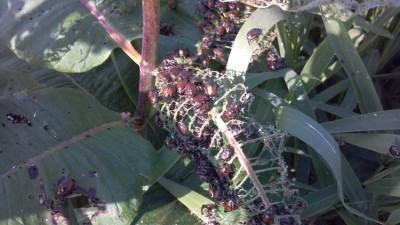 Skelotonizing feeding pattern of Japanese beetles. (Source: GROWMARK, Inc.)
Skelotonizing feeding pattern of Japanese beetles. (Source: GROWMARK, Inc.)
- Japanese beetle numbers are starting to increase in corn and soybean fields.
- Soybean defoliation threshold after flowering is 20%, but this can be overestimated if only top trifoliates are evaluated.
- Treatment thresholds for corn are recommended if three or more beetles are found per ear and pollination is less than 50%.
Description and Life Cycle
Japanese beetles are starting to become more evident in fields. This publication goes over this insect and potential in season management strategies.
Biology and Identification
Japanese beetles were first reported in New Jersey in 1916 and since then have become one of the most prevalent insect pests throughout the United States. Adults are shiny, metallic green with a coppery-brown wing cover. Six pairs white hairs line the sides and back of the body. Females and males are about ½” long, with females slightly larger than males.
Japanese beetles have one generation per year. Their larval stage belongs to the group of pests called white grubs, which can cause significant issues for emerging corn and soybean seedlings. Adults emerge from the soil from June-August (at about 1000 degree day units) and feed on the foliage of a wide variety of plants. Adults mate and females move to the soil to bury their eggs. One female can lay up to 60 eggs over a period of approximately two months. Adult females typically lay their eggs on soils with high soil moisture to ensure survival of their offspring, as eggs are very susceptible to desiccation. High numbers of beetles in a fields does not indicate white grub issues will occur the following year, as adults move long distances to find suitable soils for egg laying. The eggs hatch in about two weeks and grubs begin feeding on plant roots and organic matter. As soil temperatures cool down, the grubs move deeper in the soil and overwinter 2-6” below the soil surface. As soil temperatures warm up the following spring, grubs move up in the soil to the top few inches. These grubs feed again on plant roots and organic matter, pupate and adult beetles emerge again in late June.
Damage
Japanese beetles feed on foliage or flowers of over 300 species of plants including fruits, vegetables, ornamentals, field and forage crops and weeds. Due to their feeding habits, they are known to be skeletonizers; they feed between the veins leaving a lace-like skeleton (Image 1). The odors generated from beetle-fed plant tissue appear to be an important factor in the aggregation of beetles. In corn and soybeans, adults can reduce the yield potential by interfering with pollination in corn and damaging leaf tissue and pods in soybeans.
In corn, the adults feed on leaves, tassels, silks and pollen (Image 2). However leaf feeding is unlikely to be of economic importance. The economic damage to corn is done when Japanese beetles clip the silk before or during pollination. This can result on corn ears being partially pollinated. Silk clipping after pollination is not of economic importance as it does not affect yields.

Image 2. Japanese beetles feeding on ear tip. (Source: GROWMARK, Inc.).
In corn an insecticide treatment is recommended during silking if:
- 3 or more Japanese beetles are found per ear,
- silks have been clipped to less than ½” and pollination is less than 50% complete.
On soybeans, Japanese beetles can cause high levels of defoliation (Image 3). Scouting is important during flowering time.

Image 3. Japanese beetles feeding on soybean. (Source: GROWMARK, Inc.).
In soybeans an insecticide treatment is recommended when:
- 30% defoliation occurs before bloom
- 20% defoliation is observed between bloom and pod-fill and beetles are actively feeding
Scouting and Management
When scouting for Japanese beetles keep in mind that higher numbers may be found on field edges. These beetle counts and defoliation assessments might not always represent true pest levels and may suggest unnecessary treatment thresholds. Make sure to estimate Japanese beetle damage in at least five different random locations within your field (1 site per 10-15 acres is a good number to shoot for). Additionally, defoliation on soybeans tends to be worse on the top trifoliates. Therefore, when evaluating the severity of damage, make sure to look at trifoliates on the top, middle and bottom canopy. This will allow you to get an average defoliation per plant and avoid overestimating the damage (Fig. 4).

Image 4. Guidelines to properly estimating defoliation on soybeans. (Source: University of Nebraska Extension)
Management of Japanese beetles can be challenging as the adults are emerging and active over a long period of time. There are some insecticides labeled for control of Japanese beetles on corn and soybeans, mainly organophosphates and pyrethroids. Additionally, even though there are a few suggested treatment thresholds for these crops, there are other factors that need to be taken into consideration when deciding on a treatment option. For example, when plants are under other types of stress such as drought, the treatment threshold may need to be adjusted.